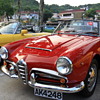Posted 11 years ago
 NicoleJere…
NicoleJere…
(439 items)
Shown are two tintype photographs from c. 1900, one of which is inside a paper mat and was photographed at Mann Bros Photo Gallery in Sacandaga Park, New York. Below is a brief overview of the tintype from Wikipedia:
"A tintype, also known as a melainotype or ferrotype, is a photograph made by creating a direct positive on a thin sheet of iron coated with a dark lacquer or enamel and used as the support for the photographic emulsion. Tintypes enjoyed their widest use during the 1860s and 1870s, but lesser use of the medium persisted into the early 20th century and it has been revived as a novelty in the 21st.
Tintype portraits were at first usually made in a formal photographic studio, like daguerreotypes and other early types of photographs, but later they were most commonly made by photographers working in booths or the open air at fairs and carnivals, as well as by itinerant sidewalk photographers. Because the lacquered iron support (there is no actual tin used) was resilient and did not need drying, a tintype could be developed and fixed and handed to the customer only a few minutes after the picture had been taken.
The tintype's immediate predecessor, the ambrotype, was the same process using a sheet of glass as the support. The glass was either of a dark color or provided with a black backing so that, as with a tintype, the underexposed negative image in the emulsion appeared as a positive. Tintypes were sturdy and did not require mounting in a protective hard case like ambrotypes and daguerreotypes."















I've had an interest in this subject but avoided asking as the people "in the know" seem to try to act superior & irritating. You did a great job of explaining the differences as "Early Photography For Idiots". Now, I have enough understanding to really show them what an idiot I am. Just joking! Appreciate the much needed info..
Hi, blunderbuss2,
Thank you for your comment. :) I can relate to what you said about people "in the know," and I do my best to be the antithesis of those people (informative yet humble and receptive to input)! And I'm glad you like the description for these tintype photos, but I'm afraid I can't much credit for it, as a majority of it came from Wikipedia (which probably places me in the "Early Photography for Idiots" club haha). Anyhow, thanks for stopping by!